Coffee Review’s list of the Top 30 Coffees of 2020 represents our eighth annual ranking of the most exciting coffees we tested over the course of the year. The Top 30 celebrates and promotes coffee roasters, farmers, mill operators, importers, and other coffee industry professionals who make an extra effort to produce coffees that are not only superb in quality but also distinctive in character.
Over the past 12 months, we cupped over 2,000 coffee samples and published more than 450 reviews, both significant increases over past years. The coffees we chose to review were primarily high-rated coffees, which are of most interest to our readers. This year, about one in four coffees we tested scored 90 points or higher, and nearly 200, almost 10% of the total, rated 94 or higher, a tribute to the ever-intensifying innovation and dedication of the world’s leading coffee producers and roasters.
(For those curious about how we conduct our blind testing and rating processes at Coffee Review, see How Coffee Review Works. For what scores mean in respect to the wide range of coffee styles and qualities, see Interpreting Reviews.)
Going Beyond Numbers. But despite our efforts to make our ratings consistent and meaningful, numbers taken alone have limitations. You may well like a lower-rated coffee that matches your taste preferences more than a higher-scoring coffee that isn’t your style. We do our best to characterize a coffee’s character in the “Blind Assessment” paragraph of our reviews and even more succinctly in the “Bottom Line” paragraph that concludes each review.
Narrowing Down a Crowded Field
Any coffee that rates 94 points or higher, in fact, any earning 90 points or more, is worthy of special recognition. But, obviously, we could not put all of the nearly 200 coffees that earned 94 points or more in 2020 on the Top 30 list. As in past years, we selected and ranked our Top 30 most exciting coffees and espressos based on quality (represented by overall rating), value (reflected by most affordable price per pound), and consideration of other factors that include distinctiveness of style, uniqueness of origin or tree variety, certifications such as Fair Trade and organic, and general rarity.
Number 1 for 2020
The No. 1 coffee of 2020 is the 98-point GW01 Finca Sophia Olympus Geisha produced by Finca Sophia in Panama and roasted by GK Coffee in Taiwan. It is the fourth time in eight years that a coffee of the celebrated Geisha variety grown on a Panama farm has earned the top spot. However, it is the first time a roaster from outside the United States has appeared at the top of the list.

Gary Liao and the GK Coffee team at 2020 Taiwan International Coffee Show. Photo courtesy of GK Coffee.
Top 30 Statistics
Average Ratings. The average overall rating of the coffees on the Top 30 list for 2020 was 95.0 out of a possible 100, the same as in 2019, and generally in line with past averages of 94.6 in 2018, 94.9 in 2017, 95.0 in 2016, and 94.8 in 2015.
Cost per Pound: From Shocking to Reasonable. One can’t directly compare the average prices of Top 30 coffees from year to year because the mix of coffees varies dramatically. For example, the coffee that earned the No. 1 spot this year – the 98-point Finca Sophia Olympus Geisha roasted by GK Coffee in Taiwan — won first place in the washed Geisha category of the 2020 Best of Panama green coffee competition and was subsequently sold at auction for a price that broke all previous records for sale of a green coffee: $1,300.50 per pound. Which means that the roasted coffee awarded our top rating retailed for the equivalent of nearly US $4,000 per pound!
On the other hand, if we exclude that norm-busting figure, the average price of the remaining 28 non-cold brew coffees on our 2020 list was $55.46 per pound, down from the record $71.77 per pound set in 2019. Sixteen of the coffees on this year’s Top 30 list cost less than $30 per pound. Five cost less than $25 per pound, and three were priced at less than $20 per pound, namely No. 17 Thanksgiving Coffee, Moka Java (96 points; $14.50/12 ounces); No. 22 Café Kreyol, Organic Red Honey Ramirez Estate Microlot (92 points; $12.99/12 ounces); and No. 30 Skytop Coffee, Peru San Ignacio Calazobo Lot 2 FTO (93 points; $15.00/12 ounces).
Still a Bargain. If we exclude a handful of outliers like the top-rated, extremely rare and record-breaking Finca Sophia Olympus Geisha, fine coffee remains a relative bargain compared to other elite beverages. Take wine, for example. Pre-COVID-19, we routinely paid $12 to $15 in restaurants for a glass of excellent but usually not extraordinary wine. If we exclude the $4,000 Geisha, this year’s Top 30 coffees averaged $55.46 per pound, which breaks down to $1.20 per 6-ounce cup of brewed coffee, or one-tenth the price of a good but most likely less distinguished glass of wine ordered in a restaurant. And those high-rated coffees Coffee Review defines as good values cost considerably less than $1.20 per cup.
Outrageous prices asked for a handful of extremely rare and distinguished coffees can be seen mainly as a small sign of a changing coffee scene, a minor sideshow in the larger cultural drama of coffee’s journey from commodity-priced workday fuel to a mature fine beverage, worthy of study and knowledgeable connoisseurship.
Nevertheless, the Higher the Price the Higher the Rating. As in past years, higher scoring coffees on our 2020 list tended to cost more than lower scoring coffees.
98-point coffees (2) $2,088.97/pound
97-point coffees (2) $49.03/pound
96-point coffees (8) $44.62/pound
95-point coffees (7) $69.16/pound ($42.91 if we exclude one outlier)
<=94-point coffees (11) $29.05/pound
Shop the Top 30
Coffee Review’s mission is to help consumers identify as well as purchase superior quality coffees and, in the process, helping drive demand and increase prices to reward farmers and roasters who invest time, passion and capital in producing high-quality coffee. To that end, we’re pleased to provide a convenient list of links to roasters’ websites where Top 30 coffees may still be available for sale. Through most of December, we’ll update the list each morning. These coffees often sell out quickly so shop soon if you want to enjoy these coffees or send them as gifts.
Growing Regions for the Top 30 Coffees
In each of the eight years that we have published our Top 30 list, our top pick has been a single-origin coffee — meaning a coffee from a single country and region (and usually from a single farm or cooperative). Previous No. 1 coffees were produced in Panama (2019, 2015, and 2014), Hawaii (2018), Yemen (2017), Kenya (2016), and Ethiopia (2013).
This year, with eight appearances in the Top 30, Ethiopia was the most frequently recognized origin. Hawaii was second with four coffees on the list; Kenya and Panama third with three each, Colombia fourth with two.
Roasters in the Top 30
Four roasting companies placed two coffees each on this year’s Top-30 list: Paradise Roasters (No. 2 and No. 13); Taiwan’s Kakalove Café (No. 3 and No. 9); JBC Coffee Roasters (No. 5 and No. 7); and Red Rooster Coffee Roaster (No. 8 and No. 20). This concentration of coffees from certain roasters is certainly not by design. We make a determined effort to increase the number and variety of roasters that appear in the Top 30.
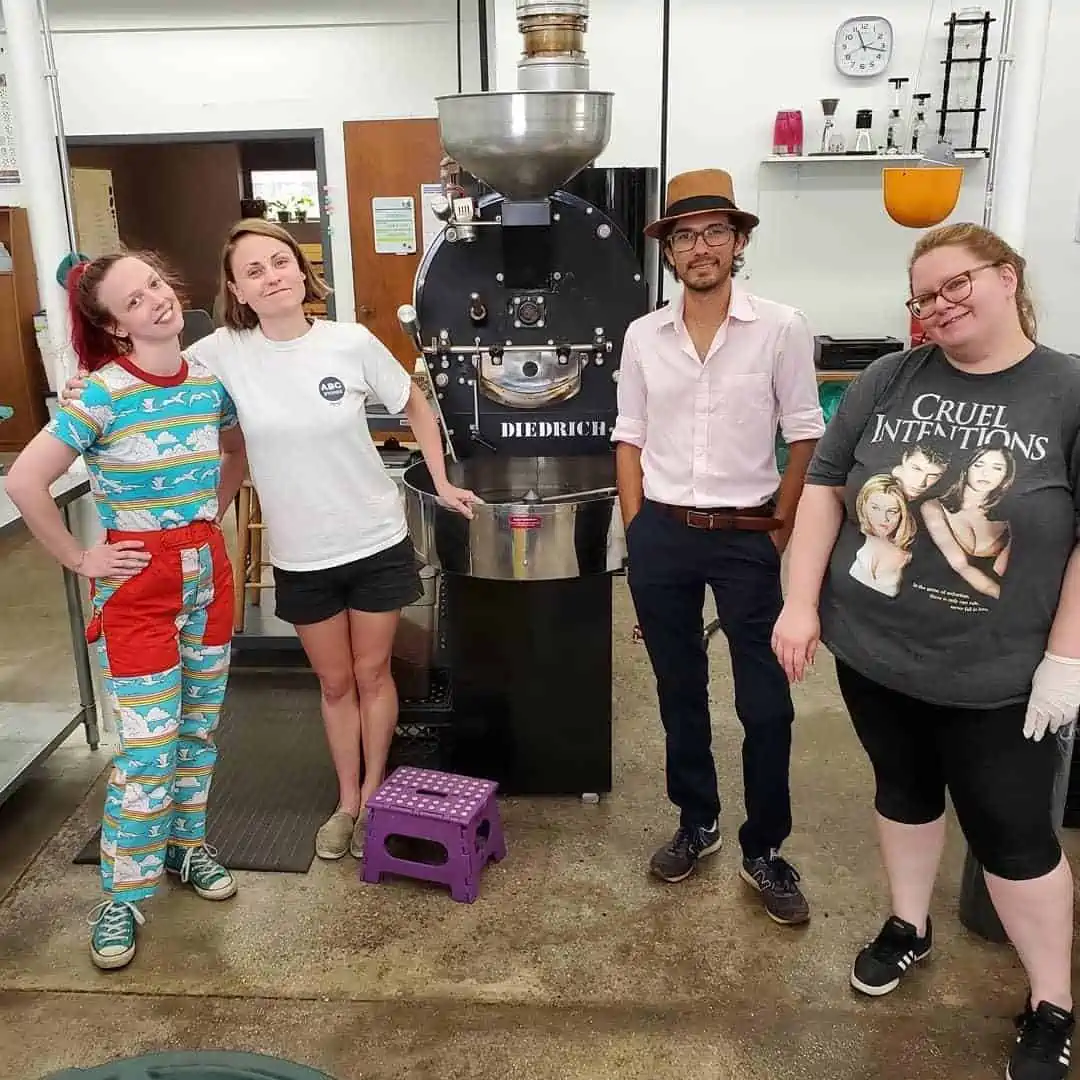
Miguel Meza and the Paradise Roasters team, roasters of the No. 2 and No. 13 coffees of 2020. Photo courtesy of Paradise Roasters.
In fact, as we did last year, we limited appearances in the Top 30 to a maximum of two coffees from the same roaster, regardless of how many high-rated coffees a roaster might have produced. While that may seem like an arbitrary limit – and it is – it’s important to remember that our list represents our assessment of the most “exciting” coffees of the year, not necessarily the highest-rated. We felt that it wouldn’t be very exciting (to us or others) if the Top 30 list were too much dominated by roasting companies that produced a particularly large number of highly rated coffees over the course of the year. Instead, we felt readers would share our excitement about an amazing coffee from a roaster that wasn’t already on the list, rather than a similarly impressive coffee from a roaster that already had two on the list.
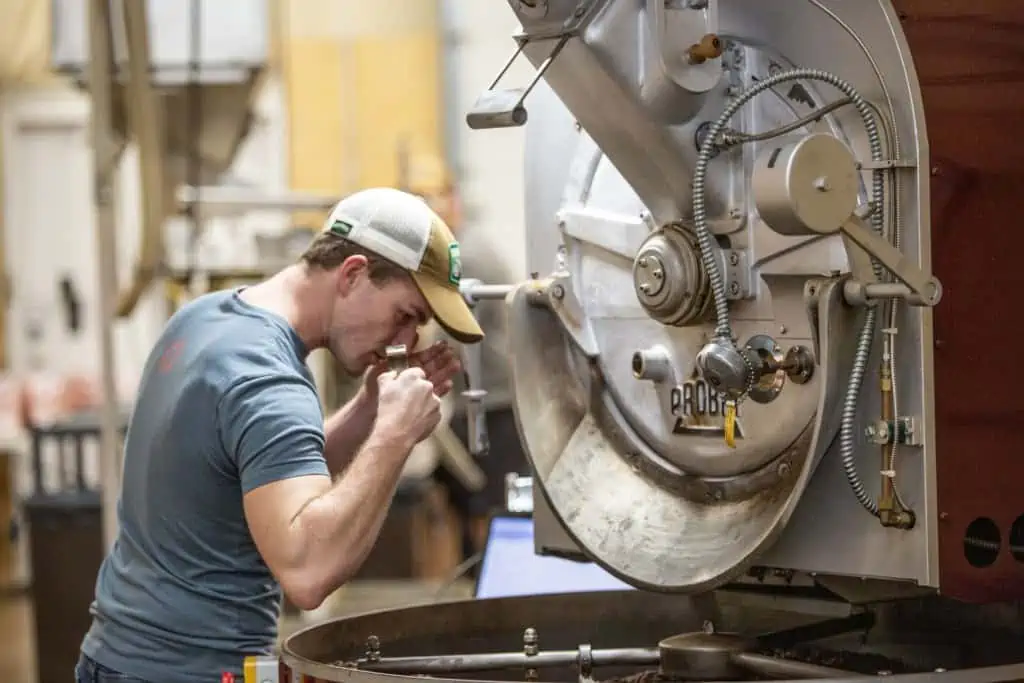
Adam Walsh, Director of Quality at JBC Coffee Roasters, roasters of the No. 5 and No. 7 coffees of 2020. Photo courtesy of JBC Coffee Roasters.
That said, Coffee Review has been, from its inception, committed to starting with what we actually experience in the cup, not with product categories or marketing considerations or fashion. It is true that we take into account extrinsic factors like value, rarity and sustainable intentions into account when we narrow the number of candidates from more than 200 to just 30, but ultimately, sensory quality and distinction in the cup, as determined by blind-tasting and as reflected in rating, is the entry point for consideration and one of the primary factors that influences where coffees land on the list.
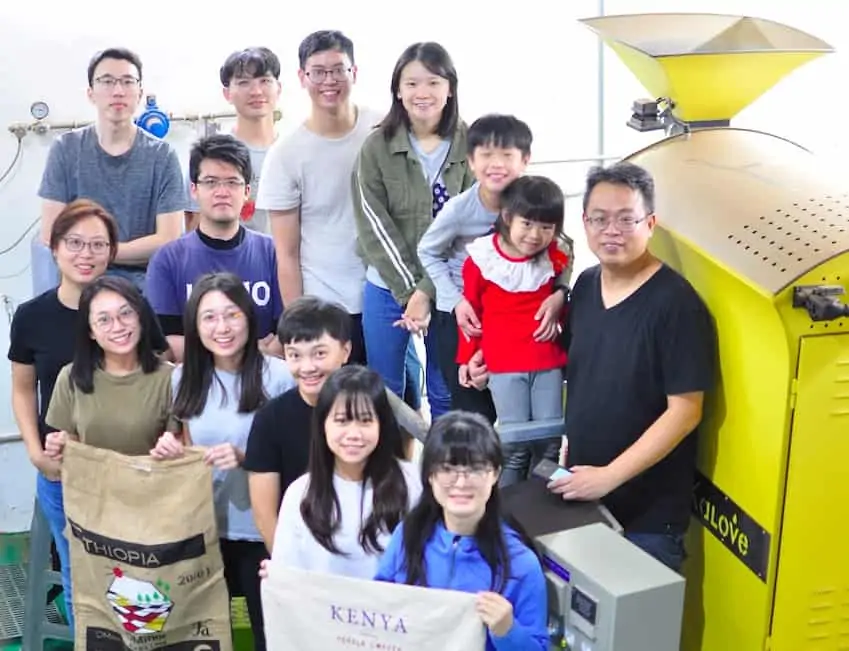
Caesar Tu and the extended Kakalove Cafe team, roasters of the No. 3 and No. 9 coffees of 2020. Photo courtesy of Kakalove Cafe.
Roaster Geography
Of the 30 coffees on the list, 26 were roasted by companies in the United States, and four by Taiwanese companies. Roasters from 12 U.S. states are represented. Hawaii and Virginia tied for the most coffees represented in the Top 30 with four each; California and Colorado were second with three each.
Increased Innovation by Coffee Growers
Coffee growers can promote taste differences in the green coffee they produce primarily in two ways. They can plant tree varieties that produce better or more interesting coffees, and/or they can process the coffee (remove the fruit from the beans and dry them) using methods that impact the taste of the cup in engaging or different ways.
Tree Variety. There are stars and superstars among the hundreds of varieties of Arabica grown in the world today, and coffees from these more distinguished varieties frequently earn high ratings at Coffee Review. This year was no exception. Variety was identified for 19 of the Top 30 2020 coffees. Among the 19, six famous varieties appeared twice: The celebrated Geisha (also spelled Gesha), the old and respected Bourbon, the famous Kenya varieties SL-28 and 34, the recently emerged Ethiopia variety Wush Wush, and the traditional standards Typica and Caturra. Among the varieties that appeared once were three that are striking in bean appearance as well as cup character: the tiny-beaned Mocca and the giant-beaned Maracaturra and Maragogipe.
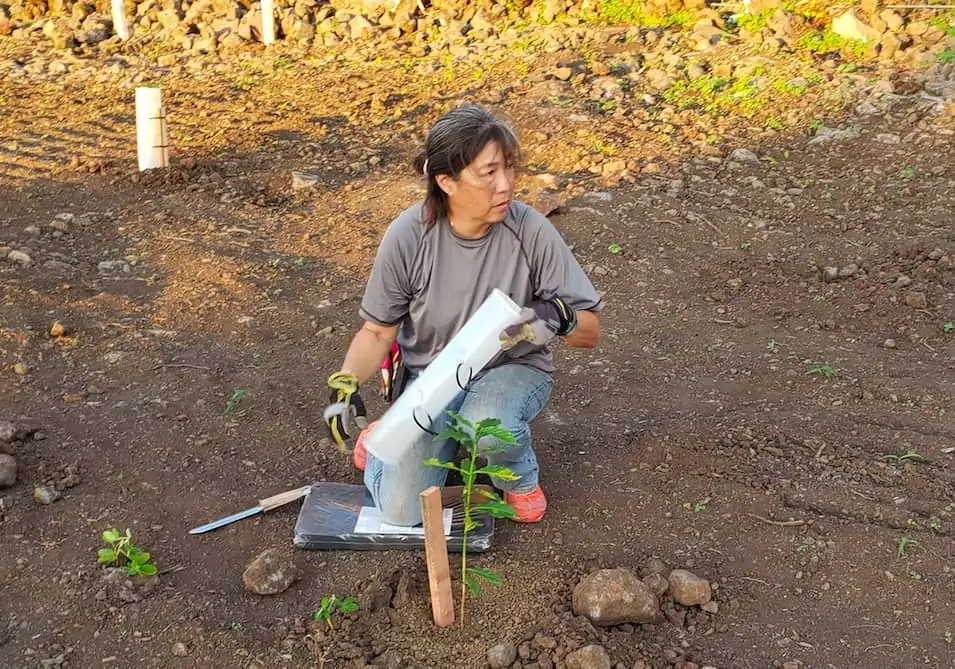
Karen Patterson planting Kona Mocca® seedlings at Hula Daddy, producer and roaster of the No. 6 coffee of 2020. Photo courtesy of Hula Daddy Kona Coffee.
Processing Method. The trend toward differentiating coffee cup character through applying unorthodox processing methods accelerated in 2020. On last year’s list, for example, among the 25 coffees for which processing method was clearly identified, 11 were produced using variations of dry or “natural” processing, meaning the beans were dried inside the fruit rather than after the fruit has been removed, as is the case with more traditional wet-processed or “washed” coffees. That 2019 figure was up from seven such natural-processed coffees on the list in 2018 and six in 2017.
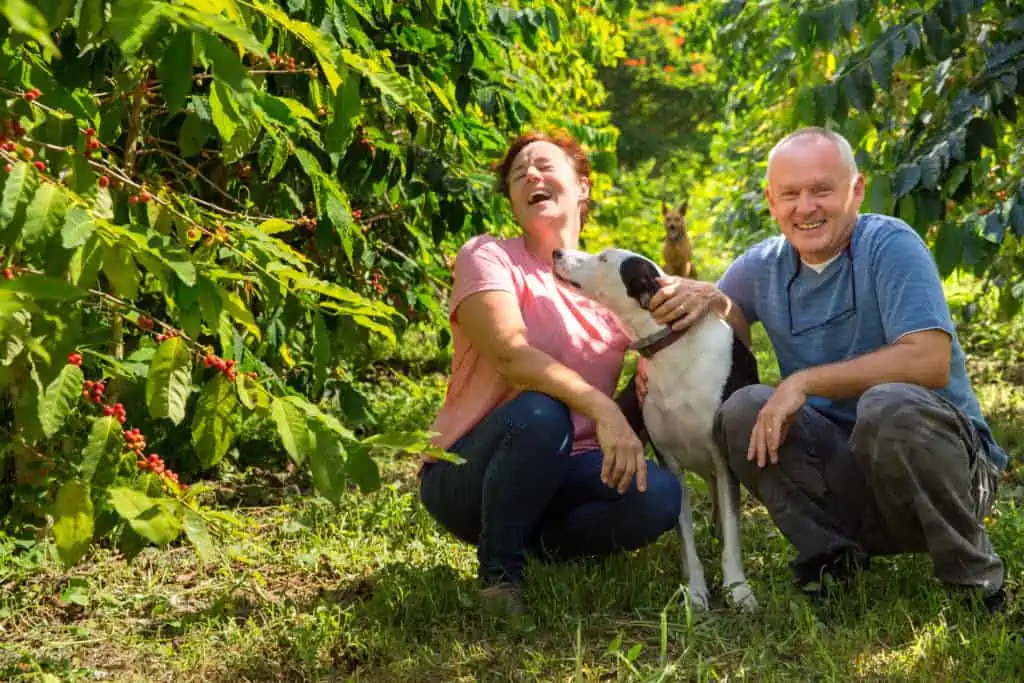
Danielle and Jean Orlowski, with Scarlett (center), of Hala Tree Kona Coffee, producer and roaster of Honey Typica Anaerobic, the No. 15 coffee of 2020. Photo courtesy of Charla Photography.
In 2020, however, we saw a turn toward experimental or hybrid variations that largely transcended the old washed vs. natural processing categories. True, of the 25 coffees on the list that identified processing method, five were prepared by the natural method and ten by the orthodox washed method. But eight were processed using innovative techniques that defy traditional processing category: anaerobic (limited oxygen ferment), thermic (heat applied to skinned or pulped beans), or various hybrid methods. In most cases these methods involved often radical experiments with fermentation, once seen as a troublesome but necessary step in removing fruit residue during the orthodox washed process, but now being approached as a creative tool to innovate cup character. And this year three additional coffees on the Top 30 list were processed by variations on the honey method, meaning that some fruit flesh or “honey” was allowed to adhere to the beans during drying.
Fewer Espressos
We saw only two espressos make this year’s list, both single-origin Kenyas (No. 7 JBC Coffee Roasters, Karimiuki Espresso; No. 11 Simon Hsieh Aroma Roast, Kenya AA Area Phoenix Special) compared to five espressos on the 2019 list and six in 2018. This drop-off may be related to the impact of COVID-19. Coffee Review cancelled its usual espresso report at the onset of shelter-in-place rules because our espresso tastings are events involving interaction among several participants. Conferences, competitions, and events where espresso brewing is featured also were cancelled, and coffee consumption patterns shifted from coffee shops, cafes, and restaurants, where espresso brewing is typically featured, to brewing at home, where non-espresso methods like drip and French press are more common. Perhaps roasters were not investing their limited time and energy in producing high-end espresso blends during these times of take-home and shelter-in-place.
Continued Achievement in the Face of COVID-19
But despite the extraordinary challenges brought on by COVID-19 on the back of ongoing economic- and weather-related difficulties in coffee lands, everyone along the specialty coffee chain seems to have persevered. Judging from the impressive quality and distinction of the coffees we tested this past year, the majority of specialty growers, millers, exporters, importers and roasters not only endured, but often triumphed. Please enjoy our list of the Top 30 Coffees of 2020.
And all the best from Coffee Review for a happy and prosperous new year, full of both coffee surprises and the reassurance of the fine and familiar.











